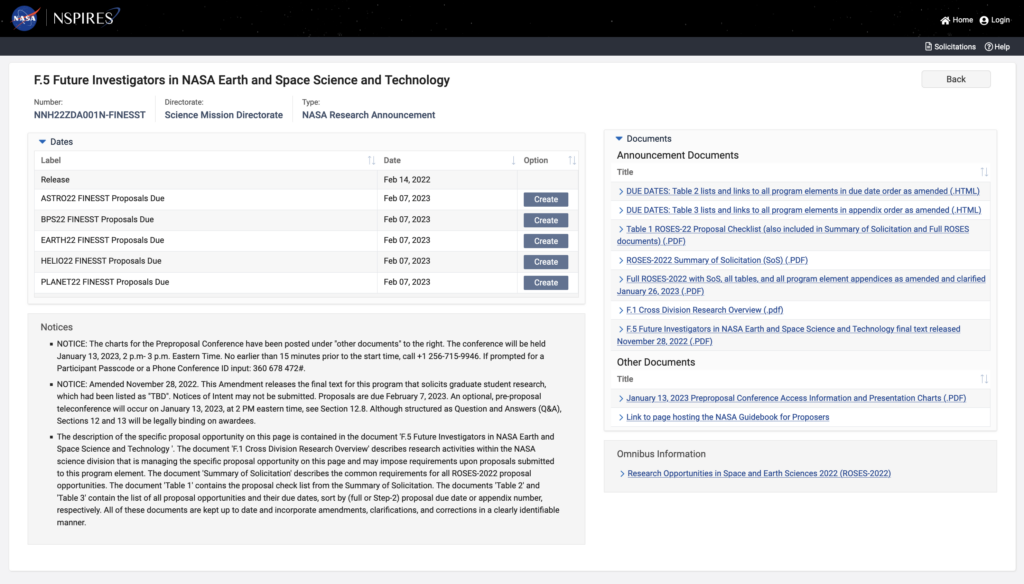Written by: Isabella Trierweiler, Pratik Gandhi, Kate Storey-Fisher, Luna Zagorac, and Abby Lee.
Table of Contents
- Disclaimer
- Introduction to FINESST
- Application Logistics
- Advice for putting together a strong application
- How applications are evaluated
- Important links
Disclaimer
FINESST is due on 14th February this year, and the solicitation webpage for the 2023 cycle can be found here. The webpage links to this document (for 2023) under “F.5” on the right hand side, which contains detailed information about FINESST, and is the main NASA document you should be referring to for any questions. For years beyond 2023, be sure to search NSPIRES (discussed later) for that specific year’s solicitation document. This guide bite represents the best effort of the authors to summarize the solicitation instructions and provide advice, but refer to the NASA document for all of the exact details.
Introduction to FINESST
FINESST (Future Investigators in NASA Earth and Space Science and Technology) is a grant award in the United States for graduate students in astronomy and adjacent fields. It is somewhat unique compared to other graduate fellowships; you do not need to be a US citizen to apply, and you can apply as many times as you would like over the course of your graduate career! When submitting, you choose to apply to one of five research programs: Astrophysics, Earth Science, Heliophysics, Planetary Science, and Biological and Physical Sciences. You can request up to three years of funding, and the award will pay up to $50,000 per year (as of the February 2023 application cycle; the amount tends to increase somewhat every 2-3 years). The total amount can be split between stipend, paying for your tuition, travel funds, material costs for research, etc. The exact split will be up to you and may be influenced by your institution’s policies.
This award differs from programs like the NSF GRFP in that it is primarily a research grant and not a “fellowship”. It provides funding specifically for your proposed research project, as opposed to receiving general funding for your merit as a graduate student. It does not require recommendation letters, but does require a comprehensive research proposal as we’ll outline later. FINESST is also unique in that while you will be the one writing the proposal, the application is technically submitted through your university by the external grants office and your advisor (more on that later). Applying can be a little more complicated than other programs since you need to coordinate with your advisor and your university’s grants office. We hope this guide helps ease the process!
First we’ll go over some logistical details to help clarify and streamline the bureaucratic process. In the second half of this guide, we’ll discuss big-picture ideas for putting forward the strongest possible application, and NASA’s criteria for evaluation. Note throughout that you (the grad student) are considered the FI or future investigator, and your advisor is the PI or principal investigator.
Application Logistics
Intro to NSPIRES
NSPIRES is the official NASA platform for applying to grants, and this is what FINESST uses as well. To kick things off, you will have to make an account, as will your advisor if they don’t have one already. NSPIRES also hosts the official solicitation for FINESST each year (the one for 2023 can be found here and is due on 7th February 2023), which contains all of NASA’s documentation as well as the link to start a new proposal.
Figure 1 below shows what the NSPIRES landing page for FINESST looks like – after logging into their account, your PI can start a new proposal by clicking on the “Create” button next to the relevant category, as shown below.

Make sure your advisor and department administrators know you are applying!
It sounds obvious that you should let your advisor know you’re applying, but it is especially important for FINESST because the application relies heavily on other people! Your advisor will need to start an application as the PI and then add you as the FI under the position of “Graduate/Undergraduate student”. As part of the application material, you will need your advisor’s 2-page CV, signoff on a mentoring plan, and funding information, as we’ll outline later.
Additionally, each application requires someone from the university/institution’s grants office to have an NSPIRES account and be part of the application, and they will be the person to make the final submission on your behalf. This person usually holds a position called something like “External Grants Analyst”, and is part of either Grad Studies or the campus grants office. If you are not sure who this might be, it’s a good idea to ask your advisor or department office, or email the Graduate Studies division. Once you’ve found the person, you should also ask them if your institution has an internal submission process for FINESST independent of NSPIRES (the deadline for this could be earlier or later than the NASA deadline, depending on your institution).
Required material for FINESST
Below are all of the documents that need to be included in your application – we understand that this list can look intimidating, but we’ll break it down step by step! Note that one or two of these items are the most important, with the rest being boilerplate or a matter of just listing things for bureaucratic purposes. Work through the sections one by one and remember that your main tasks are the research proposal and the research readiness statement. For the final submission on NSPIRES, you will have to include all of these documents in a single PDF, in the order listed.
(There are tips for specific sections later, but refer to this list whenever you need an overview.)
- Table of Contents – you can just add a page listing everything that follows, with page numbers
- Science/Technical/Management (STM, max. 6 pages not including references): This is your research proposal! Within the proposal make sure to include:
- Background and main research questions you will address
- Goals for the project (explicitly outlining the research motivation and your proposed work)
- Description of your previous work on the topic
- Timeline for what work you will aim to accomplish within the grant award period (1, 2, or 3 years) – explicit detail is key here!
- Description of how your work is relevant to NASA
- Mention any other ongoing NASA funding that your PI has and a justification for why your work will differ from projects that are already NASA-supported
- References and Acknowledgements (no page limit)
- A list of references/citations for your STM section
- A statement that you wrote the proposal, and acknowledgement of any editing support from your PI, collaborators, or peers (this can be fairly boilerplate text; limit of up to 150 words)
- Research Readiness Statement (max. 1 page):
- Outline your relevant coursework and technical (eg., coding, instrumentation, observing) skills
- Describe relevant previous research experiences, papers, conference talks, etc.
- A brief outline of your graduate study timeline – this is your degree program (like “PhD in Astrophysics”), start date and dates of any degrees earned (like an M.S.), and anticipated graduation date
- CV for the PI (max. 2 pages) – your advisor’s CV
- CV for the FI (max. 2 pages) – your CV
- Current and Pending statement for the PI – a list of all of your advisor’s ongoing funding sources, and any funding they are expecting in future months
- Current and Pending statement for the FI – a list of your ongoing funding (if you don’t have other ongoing fellowships you can just write “No current and pending to report”)
- Mentoring Plan (max. 2 pages) – the format for this is flexible. If your university has a standard mentoring plan form you can use that, or feel free to write your own. Some basic things it should include are:
- Statements saying both the PI and FI are committed to the project
- Outline of how frequently the PI and FI will meet
- Goals and objectives for the PI and FI for the duration of the fellowship
- What the PI is expected to contribute to the working relationship, and what the FI is expected to contribute in return
- Budget, Narrative, and Timeline (max. 2 pages unless special documentation needed, like if you are at an institution that is not an educational organization)
- This is something you can obtain from a department administrator. It should include the breakdown of funding per year, including tuition and fees, stipend, and travel allocations.
- An example would be to split the annual $50,000 award into a $40,000 stipend, $7,000 towards your tuition/fees, and $3,000 in conference/travel funding. Your mileage may vary of course, if for example you need funds to purchase research equipment, but you can change the budget to suit your needs as long as the total does not exceed $50k per year (as of the 2023 cycle).
- Note that if the amount you allocated for tuition does not cover your full tuition, fees, and student health insurance costs, your university will generally cover the rest if you receive the award.
Note: there is an *optional* high-end computing (HEC) appendix, which you can submit if you are seeking computing time on NASA supercomputers for your research. If you choose to do this, you should justify why you are requesting computing time in your main proposal (STM section). The HEC application is not part of the main application PDF, but rather uploaded as a separate appendix. For this, the PI (not the FI!) has to submit a request at this link and save a PDF at the end of the request process, which you the FI will then upload as an Appendix document in your application on NSPIRES.
Figure 2 highlights what the main application interface on NSPIRES looks like once your PI has created the proposal and added you to it. Under the five “element” links from Proposal Summary to Proposal Team, you as the FI will have to fill out the necessary information – often this info has significant overlap with the materials you will prepare (described in the section below), so you can use those to fill out the various text boxes. Under “Proposal Team” is where you will have to add the person from your institution’s Grants Office, as a “Support Staff” member of the team. At the bottom, “Proposal Document” is where you will upload your single PDF containing all application materials, and “Appendix” is where you upload the option high-performance computing application PDF, if you are applying for computing time.

Advice for putting together a strong application
Tips for the Science/Technical/Management section (i.e., the research proposal)
The research proposal is the heart of your application. You can roughly split it into three main parts – introduction/background, work you’ve done so far, and detailed description of how you plan on tackling your thesis work in coming years. The final part should also contain a description of how getting the FINESST award would help with your thesis goals.
Relate your research to NASA’s science goals: When motivating your project, make sure you very clearly highlight how your work ties into NASA’s goals. You can find NASA’s latest science strategy plans here, and you could also refer to documents like the Astro2020 decadal survey. Spend roughly a paragraph of your proposal elaborating on how your science will contribute towards specific goals in these plans, and you can even cite specific passages and page numbers in the documents as needed.
Contingency plans are key: This is a research proposal, and research doesn’t always go the way you anticipate. So it is important to include lots of detail as well as concrete backup plans for your work. You need to communicate that valuable science will still come out of your work even if, say, your observations don’t go as well as you had hoped, or if there are issues with generating your new simulations. It is also important to acknowledge any limitations to your work – you don’t want your reader to object to any caveats that you haven’t thought of.
Make your proposal easy to read: You want your readers to see the importance of your proposed project as quickly as possible. Definitely use figures, as including plots, timelines, and/or graphics can be really helpful. Figures can be used for background motivation, but it is also often useful to include preliminary results or proof-of-concept plots to show that your research plan is robust. Pay attention to the overall look of your proposal – use whitespace, sub-headers, and bulleted lists to help your application reader skim through the proposal smoothly. A judicious use of italicized and bold text to highlight key ideas and drive your message home is never a bad idea!
Read examples and get feedback: There are a number of past FINESST proposals (both successful and unsuccessful) that people have made available online – see the “Important Links” section at the end of this bite for examples. Some people have also made their feedback from NASA public. Everybody’s research is different, but you can use these to get an idea of what is expected for a theory vs observation project, or what is typical of projects in your subfield. As you are writing your proposal, you should also ask multiple people to read it – both people in your field and outside of it. Your application will be read by astrophysicists but likely not experts in your specific sub-field (e.g., modelling stellar atmospheres), so it is important to make sure your proposal is understandable to someone without your highly specific domain of background knowledge.
Speciifc advice for the observers: If you plan on writing a proposal focused on observational research, be sure to show that your planned analysis is possible given the data. Check telescope documentation for helpful calculators (such as the Hubble exposure time calculator) so that you can demonstrate the data will be sufficient for your methods.
Other general suggestions
- Don’t stress too much about the mentoring plan and the budget, as long as you have written something that is reasonable to you and your advisor. Definitely focus the majority of your efforts on writing a strong proposal and research readiness statement!
- Read other people’s proposals to get a sense for what they can look like – very different approaches can be successful!
- You can submit every year and it gets easier every time, so don’t be afraid to try and learn from your mistakes.
- Tell yourself how awesome you are for writing an entire proposal, no matter what! 🙂
How applications are evaluated
The review process involves an assessment of strengths and weaknesses of each of the following criteria:
- Scientific merit of the proposed research – this includes the depth of understanding of the topic demonstrated by the FI, the expected impact of the research, the feasibility of the proposed plan, and whether the FI has accounted for potential setbacks and contingency plans.
- How relevant the proposed research is to NASA’s high-level goals and objectives, and how well this has been articulated by the FI.
- Assessment of the FI’s research readiness – demonstration of good understanding of the research topic and general astrophysics, the FI’s background in coding, instrumentation, observing, or any other relevant technical skills, and whether the PI is well suited for mentoring the FI in the proposed research.
We hope this guide is helpful as you put together your application! This is based on the experience of the five of us who have gone through the process, and it is important to note that FINESST is quite competitive. So if you are not selected this year, you can always incorporate the reviews and feedback into your proposal and try again next cycle!
Important links
NASA’s NSPIRES platform, where you will find the application and supporting documents: https://nspires.nasaprs.com/external/index.do
Link to the 2023 main solicitation document for FINESST (you can also find this document from the main NSPIRES page): https://nspires.nasaprs.com/external/viewrepositorydocument/cmdocumentid=860808/solicitationId=%7BEA8742DF-E6E6-67E9-4D56-267EF31C1CDB%7D/viewSolicitationDocument=1/F.5%20FINESST_Amend70.pdf
You can find tips and example submissions from past years here, generously compiled by Michael Radke and people who uploaded their previous proposals: https://michaelradke.com/finesst/
Edited by Katya Gozman
Featured image credit: Wikimedia Commons



